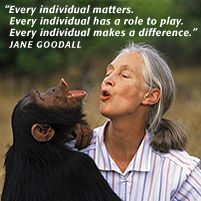Jane Goodall
(born 1934)
Jane Goodall was born in London, England, on 3 April 1934, and
grew up in Bournemouth on the southern coast of England. On her second birthday, Jane Goodall's father bought her a
beautiful, life-like toy chimpanzee named Jubilee in honor of a baby chimpanzee born at the London Zoo. Friends warned her
parents that such a gift would cause nightmares for a child. However, Jane Goodall loved the toy, and to this day Jubilee
sits on a chair in her home in England.
By the age of ten or eleven, Jane Goodall dreamed of going to Africa to live with animals. This was quite a radical aspiration in those days as young girls did not think of going to the "Dark Continent" of Africa. But Jane had encouragement from her mother, who told her, "Jane, if you really want something, and if you work hard, take advantage of the opportunities and never give up, you will somehow find a way."
Jane Goodall was determined to travel to Africa and live out her childhood dream to work with wildlife. She attended secretarial school, then got a job with a documentary film company in England until she was invited to Kenya by a school friend. She worked as a waitress to save money for the fare.
Jane travelled to Kenya by boat at the age of 23, and it was
there that she heard of Dr. Louis Leakey, a paleontologist and anthropologist. Jane made an appointment to meet him and
managed to answer many of his questions about Africa and its wildlife. Dr. Leakey hired her as his assistant, and they traveled,
along with Mary Leakey, to Olduvai Gorge on a fossil-hunting expedition.
After three months at Olduvai Gorge, the returned to Nairobi, Kenya, and Jane worked at the museum. Soon after, she and Louis Leakey began speaking about the possibility to study a group of chimpanzees on the shores of Lake Tanganyika. Dr. Louis Leaky decided Jane Goodall was the unique individual he was looking for to begin a study of wild chimpanzees on the shore of Lake Tanganyika.
At first, British authorities resisted the idea of a young woman living among wild animals in Africa. They finally agreed when her mother volunteered to accompany her for the first three months. In July 1960, Jane and her mother, Vanne, arrived at Gombe National Park in what was then Tanganyika (now Tanzania).
In the beginning, studying the chimpanzees of Gombe was not
easy for Jane. The chimpanzees fled from her in fear, and it took many months for her to get close to them. With
determination, she searched the forest every day, deliberately trying not to get too close to the chimpanzees. On many days
Jane observed the chimpanzees through binoculars from a peak in the forest.
Gradually the chimpanzees became accostumed to her presence. Jane uncovered many aspects of chimpanzee behaviour during her first years at Gombe National Park. In October 1960, she observed a chimpanzee using and making tools to fish for termites. The discovery challenged the definition current at that time: Man the Toolmaker. Because of her research, we now know that chimpanzees hunt for meat and use tools. The longer the research continued, the more it became obvious how like us chimpanzees really are.
What some people believed would last only a few months has now become the longest field study of any animal species in their natural surroundings. Research at Gombe continues to this day, mostly by a trained tream of Tanzanians. Moral support from the Tanzanian government is a large reason for the longevity of the research at Gombe Stream Reserach Centre.
Jane Goodall received her Ph.D. from Cambridge University in 1965. She has been the Scientific Director of the Gombe Stream Reserach Centre since 1967. In 1984, Jane Goodall received the J. Paul Getty Wildlife Conservation Prize for "helping millions of people understand the importance of wildlife conservation to life on this planet." Her other awards and international recognitions fill pages.
Jane Goodall's scientific articles have appeared in many issues of National Geographic. She has written scores of papers for internationally known scientific journals. Dr. Goodall has also written books, among others Wild Chimpanzees, In The Shadow Of Man, Through A Window and Reason for Hope. She pleads to thousands of people throughout the world on behalf of her career-long sponsor, the L.S.B. Leakey Foundation. Dr. Goodall has expanded her global outreach with the founding of the Jane Goodall Institute based in Ridgefield, CT. She now teaches and encourages young people to appreciate the conservation of chimpanzees and all creatures great and small: The Roots And Shoots Project. She lectures, writes, teaches and continues her mission in many inventive ways, including the Chimpanzee Guardian Project.
Jane Goodall attributes her dedication and insight to her work and mission in life to her mother, the internatinally known author Vanne Goodall. In 1985, Jane Goodall's twenty-five years of anthropological and conservation research was published, helping us all to understand the relationship between all creatures. She has now devoted over 30 years to her mission.
Jane Goodall's message to the world:

The source
used for creating this biography is the website of the Jane
Goodall Institute.